 |
| Driving from Toronto to Charleston Provincial Park, Ivy Lea Park and back home |
We knew that early
fall would be a good time to visit the remote sites as we did not have to make
reservations and we knew school groups would not be in full force, using
interior campsites for their environmental programs. Besides, mosquitos are in
retreat and there is no need to use insect repellents.
After a leisurely
drive we arrived at Charleston Lake Park, registered at the main office and
paddled to the best interior campsites in the park—Hidden Cove (#506). It was
not occupied (although its previous occupants must have left the same day, as
their permit indicated). The site had two wooden tent platforms; we decided to
set up the tent on the farther one, near the imposing rock and used the other
platform for our equipment and daily stretching exercises. The first night was
quite cool, the temperature dropped at night to +5C—what a difference from just
a week ago, when the temperature was at least 10C higher! Well, we realized
that the fall was upon us… For some reasons, the Labour Day often does mean the
end of summer. The night was cold, but our 3 sleeping bags kept us warm.
Friday was a
beautiful, sunny day and we hiked a little. There was a hiking trail (Tallow
Rock Bay East Trail) just on the ridge above our campsite. We headed over to
the bridge between Charleston Lake and Slim Bay (the bridge was closed in 2014,
hopefully temporarily), passing very interesting rock formations and old growth
forest. It was a mystical place. We crossed the bridge and Catherine went on in
search of Bob’s Cove campsite, but upon seeing some campers, she did not want
to invade their privacy, so she retreated and we headed back to our campsite.
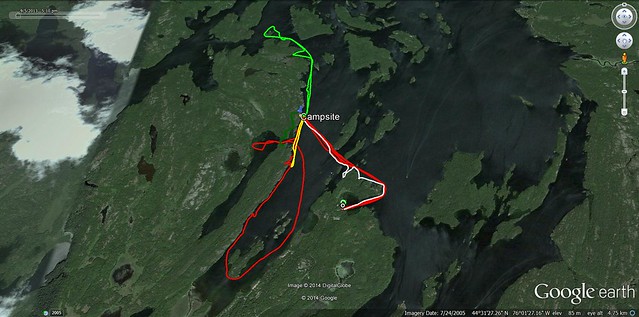 |
| GPS track of our paddling on Charleston Lake |
The next day
(Saturday) we paddled to the car (as there was a 60% chance of rain) and drove
around the campsites in the park, rating their differences. Of course, we also
visited the famous rock shelters.
 |
| Rock Shelters in Charleston Lake Provincial Lake |
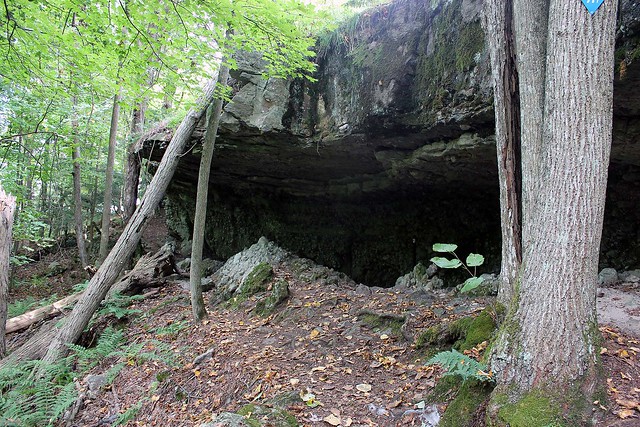 |
| Rock Shelters |
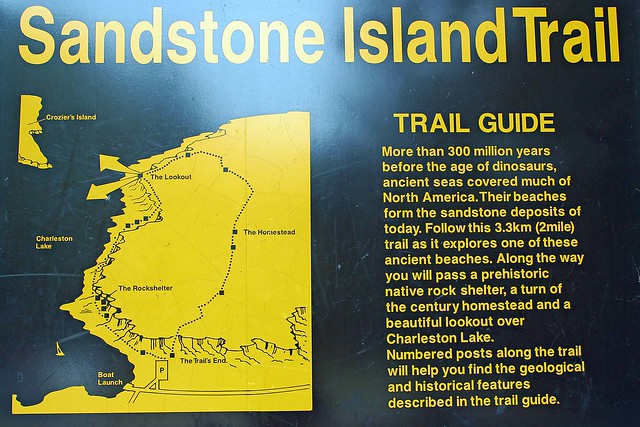 |
| Sandstone Island Trail passes a prehistoric rock shelter |
The forest around the
shelters was just magical, with all the fallen trees, rocks and amazing
mushrooms, ferns and mosses. We tried to imagine the people who used those
shelters over 1,500 years ago…
Later we visited the
nearby town—Lyndhurst, with its old, beautiful stone bridge, where we had the
excellent ice cream at “Groceteria” and spent some time at a
second-hand/antique shop. It was a trip down the memory lane for Catherine. There
was a chip truck near Lyndhurst called “Petras” (whose owner was German) and it
sold excellent beefsteak tomatoes.
Another day we drove
to the town of Delta. There was an old stone mill, which I had visited in 2004.
At that time I was told there were plans to restore it and even bake bread for
tourists, but since it was closed, I had no idea if it was operational in any
capacity. There was also a gathering of “Old Bastards Vintage Motorcycle Club”—they
hold their annual motorcycle rally on the weekend after Labour Day in Delta. The
LCBO store was the busiest place in town and across the parking lot McEwan’s
gas bar and grocery store/supermarket came in as a close second. We admired old
buildings (plenty with ‘for rent’ signs) and old bridge. Sadly, the town seemed
to be in decline.
Next town we drove to
was Athens. It had very interesting murals. Coincidentally, I had visited
Athens in 2004 exactly during the Summer Olympic Games in… Athens! This visit
gave me legitimate bragging rights to boast that I was in Athens during the
2004 Olympiad!
We drove back to the
park, got into the canoe and paddled to our campsite. Crossing the lake was
quite challenging due to the strong wind and we had to make sure the canoe was
always positioned towards the waves—even though, some water did get inside.
 |
| Paddling on Charleston Lake. Recently part of this rock must have fallen off; the roots are still visible. Hopefully, no canoe was nearby when this happened! |
 |
| Paddling on Charleston Lake at Sunset is awesome! |
We spotted plenty of
poison ivy in the park, as well as hickory nuts, which are edible, but it is
very difficult to get the edible part out of the shell. From time to time we saw
majestic blue herons and of course, plenty of loon, whose calls are simply
unforgettable! The weather remained quite good—yet one night we had a rather
strong thunderstorm, accompanied by heavy rain.
We left the park on
September 11, 2013 and commenced the second part of our trip.
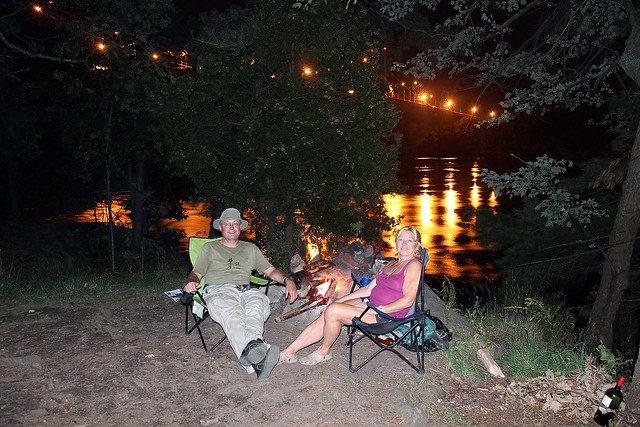 |
| Our great campsite at Ivy Lea Park, just near the One Thousand Islands International Bridge |
Bad weather was in the
forecast and indeed, the sky did look ominous. We paddled back to the park dock
and decided to leave our canoe chained to the dock in a small bay. We went to
the campsite, set up the tent and soon we were sitting around a campfire,
watching the lit bridge and the trucks crossing it. They made plenty of
rattling noise.
The bay where we left
the canoe was called Smugglers Cover. Its name conjured up a very fascinating
period of history of the River: When the USA initiated the Prohibition Era in
1920 and Ontario voted away its own dry laws, the stage was set for smuggling
alcoholic beverages across this segment of the St. Lawrence River and Lake
Ontario. With its hundreds of miles of unguarded boundary, numerous inlets,
coves and islands, the 1000 Islands region became a haven for smugglers. Many
residents, using their excellent knowledge of the River, turned out to excel at
this business.
Let me here reminisce
a little about one of my past trip. In June and July, 2001 my friend Tadeusz
Pasek and I had driven from Toronto to the Catskills Mountains, then to
Milford, Connecticut and even visited New York City (yes, we were on the roof
of the World Trade Center Tower that would be destroyed in less than 3 months!),
then drove via Saratoga, Lake Placid and the Thousand Island Bridge to Canada. Before
we crossed back to Canada, we had been planning to stay at Wellesley Island
State Park in the US—we drove there and were told there should be a few tent
campsites available. It turned out that the park was 99.9% full, packed with
huge RVs, trailers, campers and similar vehicles which were crammed like
sardines. The only campsite (or just a tiny spot) we managed to find in this modern
ghetto to pitch our tent was squeezed between two huge RVs… Yes, zero privacy
and fun! That was why we immediately decided to proceed to Canada. We spent a
few nights in Ivy Lea Park on campsite no. 121, almost under the bridge—to this
day I remember the noise caused by trucks driving on the bridge as well as boisterous
July 4th, 2001 celebrations taking place on the other side of the
border (i.e., in the RV park in the United
States).
 |
| Tadeusz Pasek |
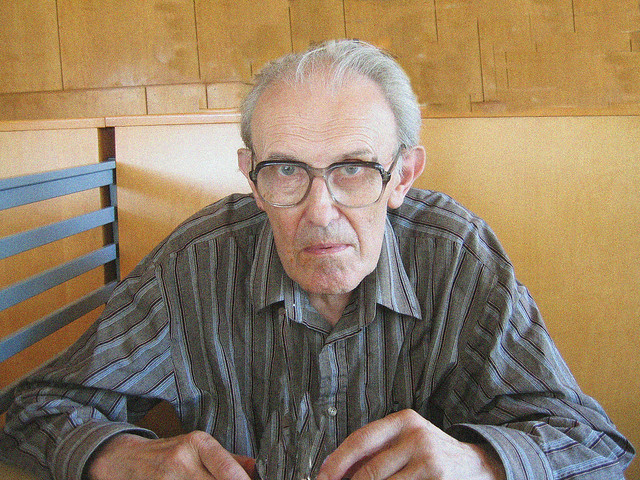 |
| Tadeusz Pasek |
By the way, Prof. Tadeusz Pasek was a well-known precursor of yoga in his native Poland—after a year-long stay in India in the 1960s, where he had practised yoga and plumbed into the mysteries of this ancient discipline under experienced Hindu yoga gurus, he returned to Poland and began popularizing mental, physical and spiritual practices and benefits of yoga, as well as wrote a book and numerous articles on this subject. Mr. Pasek passed away in 2011 in Toronto at the age of 85.
There was a terrible
thunderstorm that night, which lasted till 10:00 am o’clock. When we got up, we
decided to stay another night at the park. After breakfast we drove eastward via
Brockville. The historical sites were everywhere and we were enchanted with the
architecture of the towns we passed and we vowed to return to investigate all
the historical sites, particularly those related to the war of 1812 (between
Canada and the USA). We stopped at Mallorytown Landing where we had lunch at a
restaurant (Mallorytown’s Landing Restaurant Trattatoria ) and spoke to Dale, its
friendly owner—he had previously worked at the casino and the Constellation
Hotel in Toronto. We drove on the Long Sault Parkway, on a causeway over
several islands. Each island is a part of St. Lawrence Park System. We did not
stop to check out any of the campsites, as the clouds in the sky were
threatening and we even thought that a tornado might develop. On our way back
we experience some showers but by the time we reached the campsite, we realized
there had been no rain at all at Ivy Lea Park. So, we had a campfire and
grilled pork steaks.
The next day
(September 13, 2013) we got up in the morning, packed up, put the canoe on the
roof of the van and headed to Toronto.
We drove through
Kingston, a very historical town: there was a fur trading post established in
1673 (then Fort Frontenac), in 1841 it was the first capital of the Province of
Canada. It was indeed a beautiful town, with old buildings, renowned university
(Queen’s University), military college (Royal Military College of Canada) and a
military base (CFB Kingston). As we left Kingston, we saw the entrance to the
Millhaven Penitentiary, one of the toughest maximum prison in Canada, where
some most infamous and notorious convicts were being held—and despite faded warning
signs, Catherine decided to drive there. From afar we saw double or triple
fences and prison buildings. We stopped in a parking lot and struck up a
conversation with a young prison guard who was just walking to his car. He told
us that we were not supposed to be there and we were subject to search &
vehicle (and canoe too, I presume) seizure if we did not leave immediately. He added
that if we wanted to see the prison, we would need a special authorization form
the prison authorities… or commit a major criminal offense (although he did not
suggest the latter). So, we heeded his advice and quickly drove to the main
road.
 |
| Canoeing on the St. Lawrence River, near Ivy Lea Park |
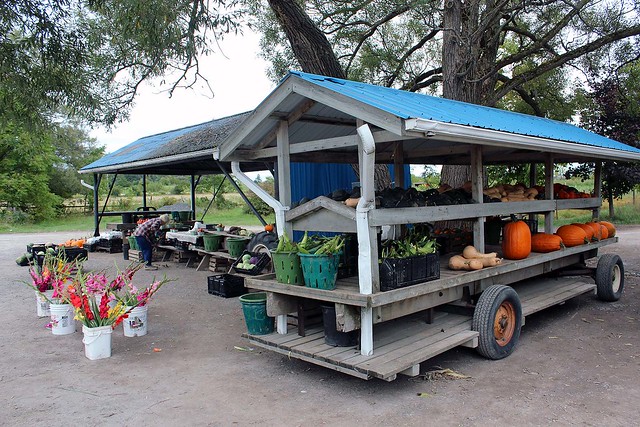 |
| Fruits, vegetables and flowers directly from farmers! |
After leaving the park
we stopped at a fruit/vegetable stand. The owner and his son had just come back
from the fields with fresh picked corn. He was a chatty Dutch man. There was a
horse and a pony in a fenced field nearby that belonged to the Dutch farmer—he
said he kept them as pets. He gave us a few corn cobs and the animals ran
towards us and eagerly started eating the corn husk and all from our hand. We
also bought excellent tomatoes, onions, garlic and two giant pumpkins, perfect
as Halloween decoration.
As I was buying
garlic, I mentioned that nine years ago I had met a very interesting fellow who
had been growing garlic and attended plenty of garlic festivals (I had even run
across photographs of him in tourist brochures). His name was Ted Maczka, he
was called ‘the king of garlic’ and ‘the garlic man’ and was residing in the
area. Well, they knew him and one of the locals said that he had recently seen
Mr. Maczka in a local supermarket! When I had met Mr. Maczka in 2004 in the
city of Perth in Ontario, during a garlic festival, I found out he was Polish,
born in Tarnow, and we continued our conversation in Polish. He walked with a
noticeable limp—he said that during the Second World War his family had been
deported by the Soviets and he had spent some time in a Soviet labour camp, he had
broken his hip and it had never been properly healed. He arrived to Canada via
Persia, Jerusalem and London.
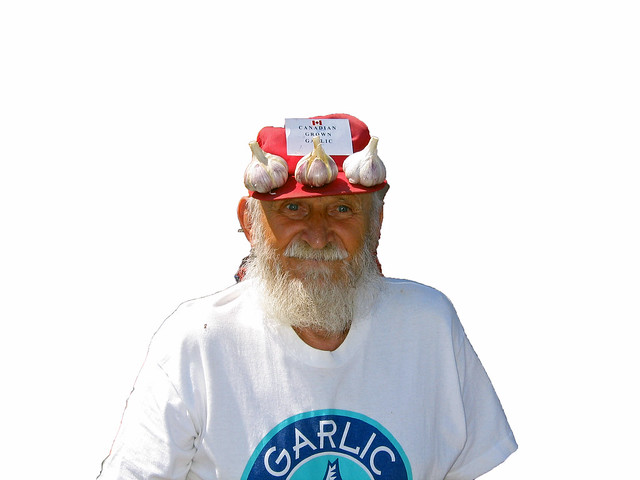 |
| Ted Maczka, 'Garlic Man'. Picture taken in the city of Perth in Ontario, in 2004, during a garlic festival |
According to
historians, the number of Poles deported to the Soviet labour camps after the
Soviet invasion of Poland on September 17, 1939 (just over 2 weeks following
the German invasion) ranges from 566,000 verified victims and a total estimate
of 934,000 victims—and at least 10% of them perished of deprivation, hunger, disease, exposure, public
executions, forced death marches and during transit.
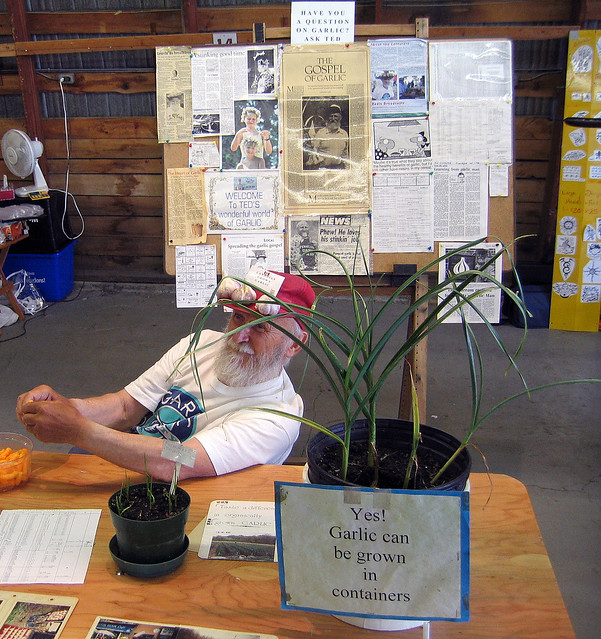 |
| Ted Maczka, 'Garlic Man'. Picture taken in the city of Perth in Ontario, in 2004, during a garlic festival |
“Tuesday was a terrific day. I came home
knowing more than I had when I went to work, which is one of the joys of
working for a newspaper. I had enjoyed the unexpected pleasure of listening to
the premier of Ontario, and to Fish Lake Garlic Lake. And I had learned
something of value—from one of them.”
Methinks the author
did not mean the premier of Ontario! Sadly, Ted Maczka passed away in January,
2014, at the age of 85 (or 87).
After a while we got
on the freeway no. 401 and arrived in Toronto past midnight, exhausted, yet
full of amazing memories!
Blog in Polish/po polsku: http://ontario-nature-polish.blogspot.ca/2014/08/na-kanu-w-parku-charleston-lake-i-parku.html
More Photos from this
trip:https://www.flickr.com/photos/jack_1962/sets/72157646257541402/

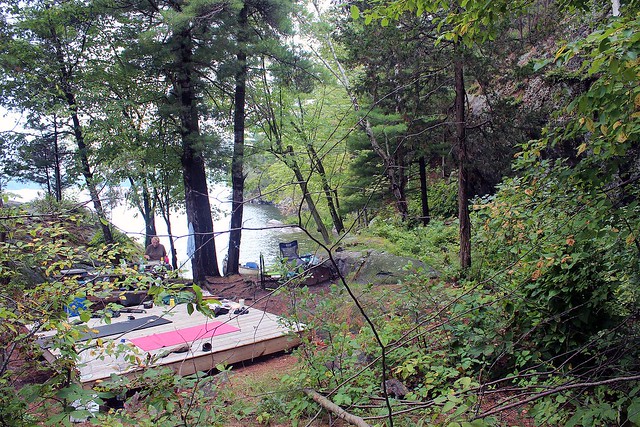

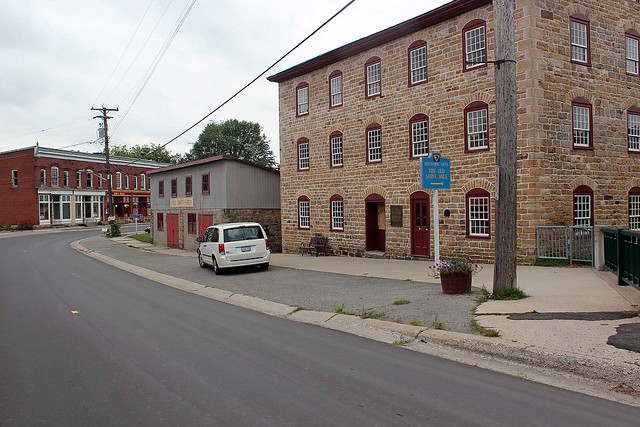


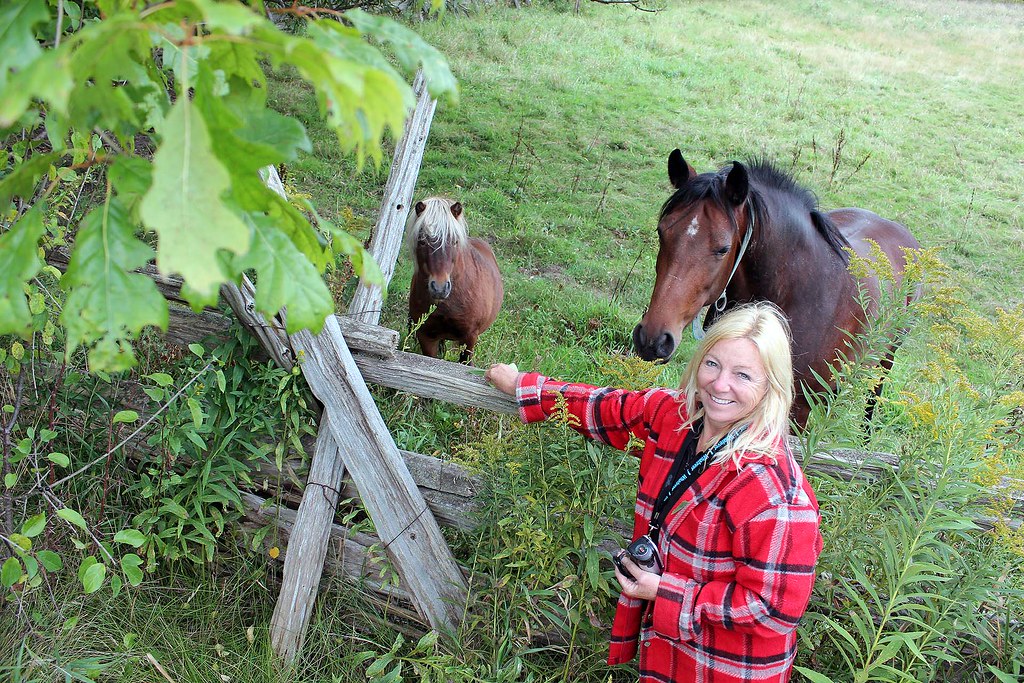
Hi a very nice story about Mr. Maczka and Mr. Pasek
ReplyDeleteThanks! Indeed, Mr. Maczka was a "character"! And Mr. Pasek was one of a kind, too! Perhaps now they're still spread their message about garlic and yoga up in Heaven.
DeleteQuestion... visiting Charleston Lake Provincial Park, same site 506, for the first time this summer. Do you remember where the outhouse is for that one? does it share with the bobs cove cluster or luck into it's own being separate from the heard?
ReplyDeleteHello! No, I don't remember where the outhouse was-but I have a feeling that we had to walk up the hill a little to reach it. I am quite sure we did not see the other campsite(s), yet I don't remember how far they were from us--we were the only ones camping in that area. It was a very nice campsite, perhaps the best in the park, and I would not mind visiting it again. I'm sure you'll enjoy it!
DeleteThx!
DeleteI just talk to my friend with whom I was camping in Charleston Provincial Park on that campsite and she did not remember seeing any other campsites nearby. Hopefully you'll enjoy full privacy!
Delete